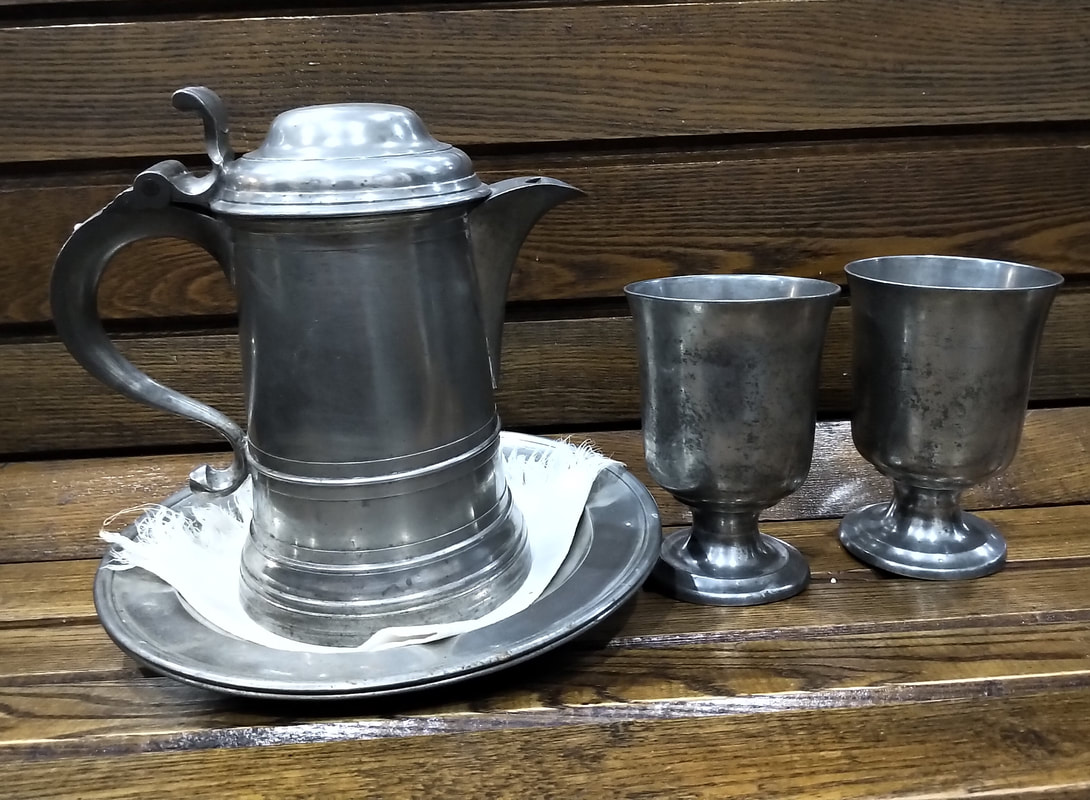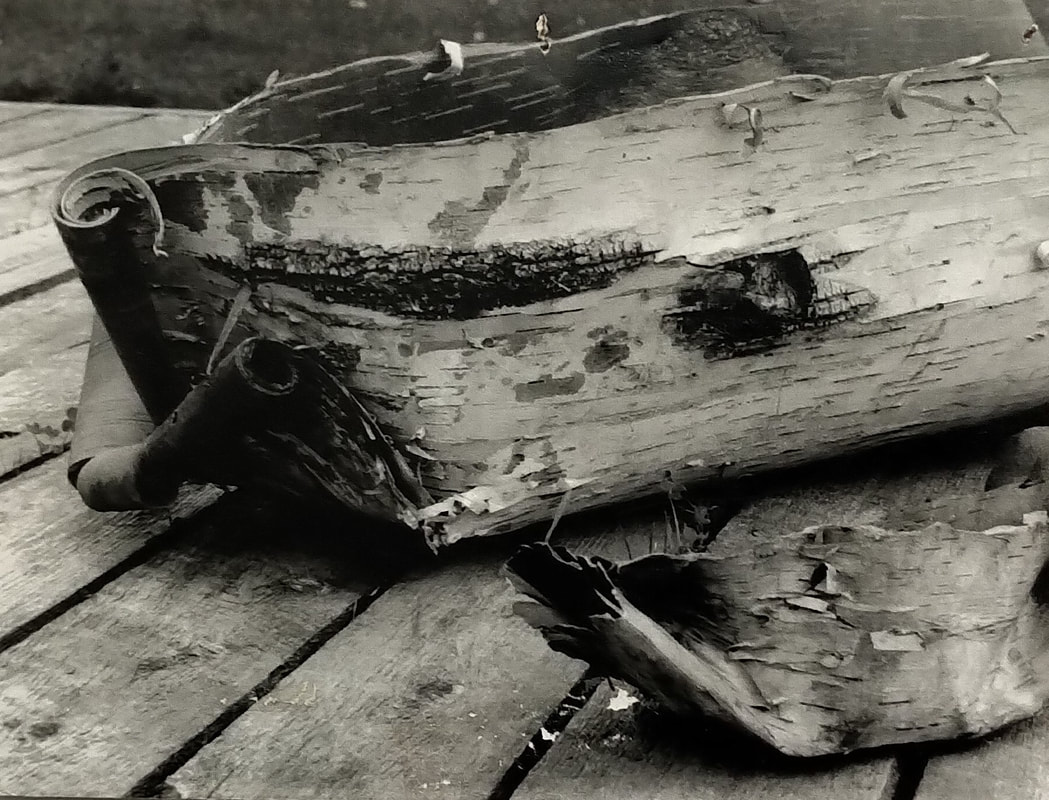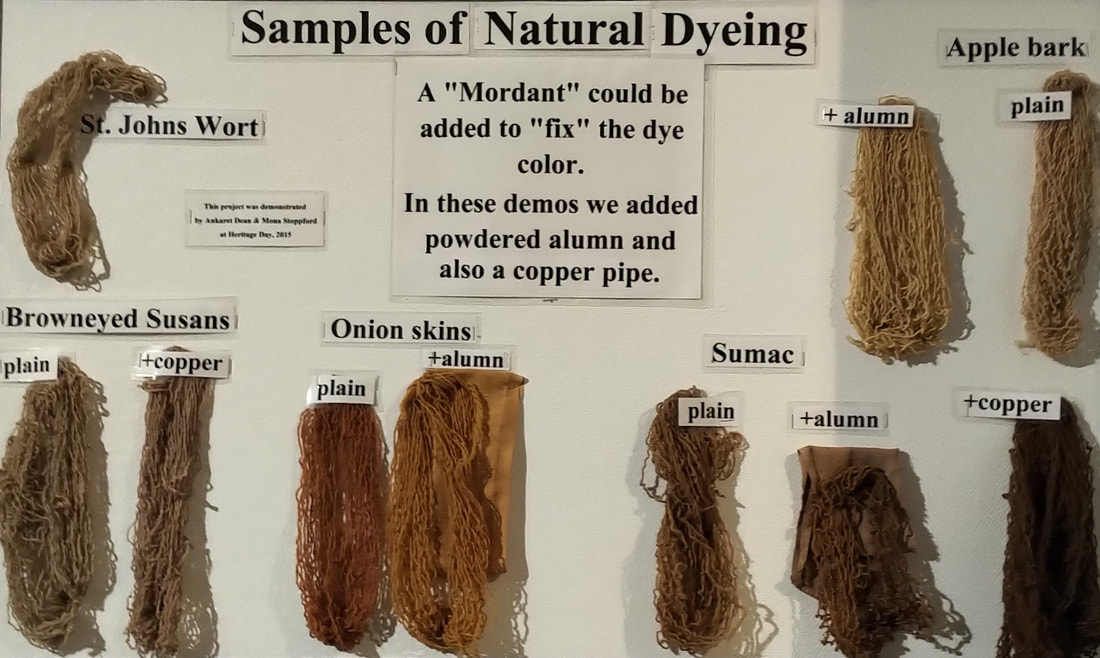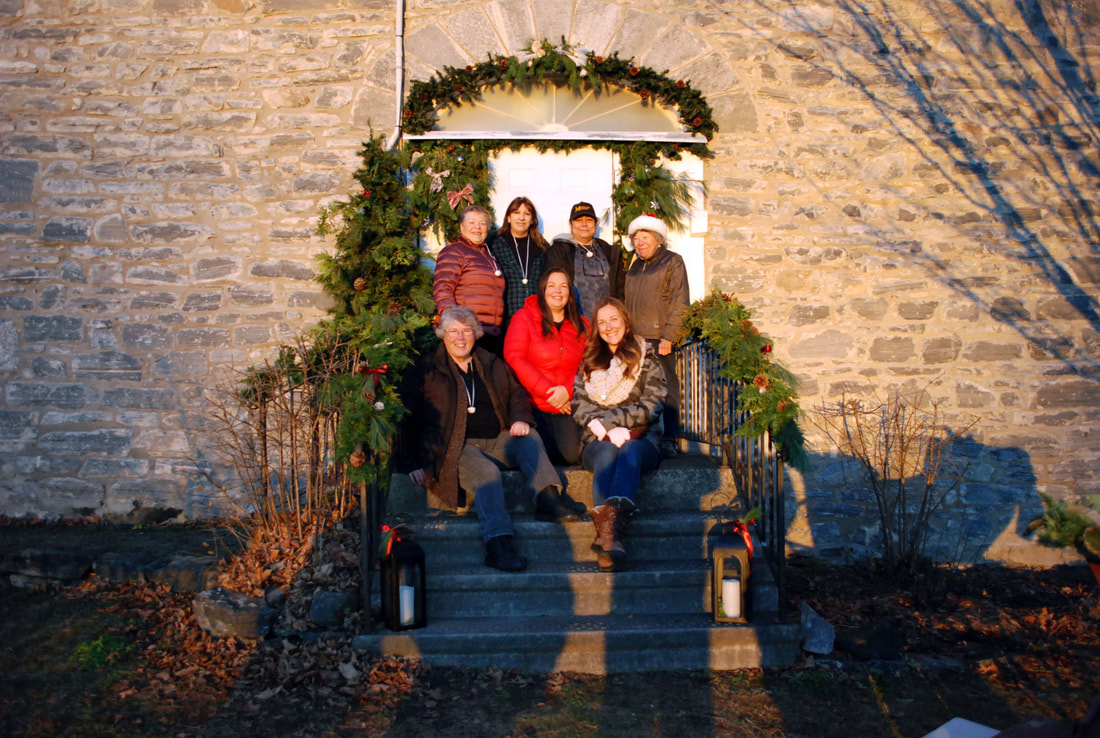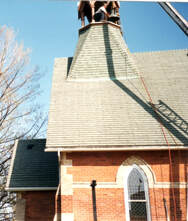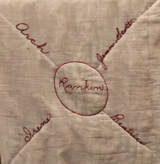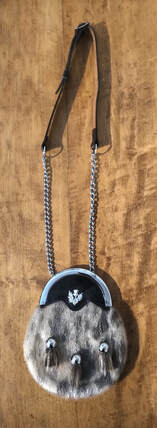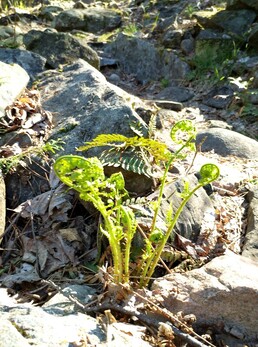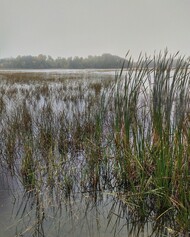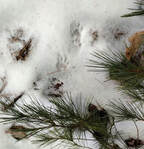|
The Baptist Churches of Middleville have a long history. A log building with four-sided roof that came to peak at a centre point was constructed on the East half of Lot 15, 6th Concession in the area known as the 7th line corner where it meets Wolf Grove Road. The pews were hewn boards that sat upon wooden blocks. When it was first used, it was non-denominational. On July 5th, 1834, a meeting was held to establish this building as a Baptist Church. The attending people adopted a Constitution with two guiding principals and five Articles of Faith to guide their Congregation. Constitution drawn up by founding members of the Baptist Church on Saturday, July 5, 1834 Article 1: The Church shall be an independent Baptist Church, possessing the sole power and right of managing all her own concern, both spiritual and temporal, under Christ our Head, meeting every Lord's Day and attending to the things according to the pattern of the First Churches. Article 2: Persons who give credible evidence of piety shall be admitted as members of this Church on profession of their faith and attending to the Ordinance of Baptism by immersion of water. The congregation met in this building until 1859 when a second building was constructed on a second site.  Middleville Baptist Church on left and former manse on right. Photo 1905 Pictured: at door, Mr. Nichols (brother), Reverend Nichols, Crawford Dodds, at fence: Addie Allan, Clara Croft, Mrs. AH Croft, Evelyn Rankin, Jennie Affleck, Maggie Blackburn, Agnes Affleck, in buggy: Tena Dodds, Mrs. Reverend Nichols, Nichols children and dog named Faust In 1850, a plan to purchase property on Lot 15, 5th Concession in the heart of Middleville was discussed. A deal was struck to purchase the land in 1856 from Mrs. Borrowman. The names on the deed were James Affleck, Crawford Dodds and William Rankin. Logs were prepared to build the new Church which was completed in 1859. This building was used for worship until 1886 when the new frame structure was built. This last frame Church had a platform at the front where the pastor mounted two steps to the pulpit. Behind the pulpit was a sliding door that opened to reveal a galvanized immersion tank sunk into the floor. It had a wooden cover with two parts that lifted off and the tank was filled with water when there was to be a baptism Persons to be baptized descended wooden steps at one end and exited up wooden steps at the other end. The women's long skirts dripped water all the way down the aisles as they emerged. Other baptisms were conducted at a place along the Clyde River. The last Baptist Church in Middleville was closed in the early 1970's. It was only used for occasional special services after that time. In 1995, the Church was sold and is now a private dwelling. The Baptist Manses There were two buildings used as a Baptist Manse. The first is a log cabin originally built on Lot 16, Concession 7 and then moved to Concession 8 along the Galbraith Road. This building has been moved a third time and now sits inside the Middleville and District Museum as an example depicting log cabin living in the late 1820’s and ‘30’s. The Baptist Manse was constructed beside the Church in the village. It was later sold to Arthur and Ethel Croft and used as a private residence.
The Baptist Churches of Middleville and their manses were an important part of the community for many decades. When you visit the Middleville and District Museum, be sure to look for the history and artifacts of the Middleville Churches in the Museum's Church exhibit.
0 Comments
Earth Day is a time for reflection on how the people who have come before us interacted with their natural surroundings. Indigenous people relied on the environment for food, clothing, spiritual guidance and renewal. Where they lived and their travel patterns were governed by the cycles of nature. Their hunting activities moved with the seasons and the migration of animals. The phases and cycles of the moon were named according to their activities at certain times of the yearly cycle. Learn about the names by clicking the link. Indigenous Moon names Their diet depended on the seasonal availability of food they foraged from nature. They followed the cycles of the trees to harvest maple sugar in the spring. The sugar was stored over summer and winter months to sweeten and also preserve food. They used smoking techniques to extend their food supply. They harvested and dried herbs and other plants for flavouring and medicinal purposes. Honey was gathered for sweetening and medicine. When Indigenous people hunted, they utilized all parts of the animals. They used every part of the plants and trees they gathered and cut so that nothing was wasted. They cared for the earth as it cared for them by providing everything they needed to survive. The settlers learned to be frugal with their resources as there was limited access to supplies. They used the sun to dry and preserve their food. Cold cellars were dug into the ground to take advantage of the natural coolness of the earth and use the cold temperature to keep food from spoiling in the summer heat. They learned to harvest and use the plants they found around them. Their diets were governed by what items were available seasonally. Their homes were built to take advantage of the southern exposure. Door yard gardens were planted to make good use of the warm temperatures beside the building. These gardens produced herbs to provide flavouring and much needed medicinal ingredients. Gardens were crucial to sustain the family and seeds were carefully kept for future crops. A few potatoes would be saved to use as seed potatoes to produce the next crop. They would be careful not to use their last seed or plant. Several plants were used to create colour for knitting and weaving projects. The Museum has an informative display of some of the materials used for natural dye. Many decades ago, people knew how to live in harmony with the natural world around them. Today there are people who embrace sustainable environmental practices. It is definitely more challenging in the busy world we live in now. Earth Day is a perfect time to think of how what the people before us did out of necessity and how it was actually a way to live a satisfying life in harmony with nature. Take some time to enjoy the nature around you on Earth Day!
The strength and heart of an organization can be seen in the hours of dedication its volunteers commit to it. The Middleville and District Museum has attracted and sustained a long list of individuals and families that have answered the call for decades. In fact, for six decades now. The faces may change over time, but the resolution remains constant. Generations of families have been a part of building, developing and sustaining the Museum. New people join in to keep the Museum moving forward while always maintaining the principles of the past. New technology and outreach blend in with the tried and true processes of a phone call or hand written note. Bringing people together to share in a community based endeavour has always been at the center of the Middleville and District Museum’s mandate. The Museum survived the challenges of the past few years and has renewed its energy with a vigorous new slate of activities planned for all ages to enjoy in the 2023 season that runs from opening weekend on May 20th to the end of November with a Christmas themed event. The Middleville and District Museum has no paid staff and relies solely on the many hours of work logged by the volunteer Board of Directors and all the people who step up to open its doors to the public each weekend and support the running of monthly events. Everything that happens at the Museum is the result of a volunteer's generosity. It has been said that it might be hard to find community these days, but if you look for it, it will present itself. That holds true for the people who look to the Middleville and District Museum for community and find it there. Strong ties, connections and bonds are often formed by the people who come together to sustain the Museum. Volunteers usually get involved thinking they will find one thing by volunteering at the Museum and end up finding something completely different. Whether you have 4, 40 or 400 hours to spare, there is a place for you at the Middleville and District Museum this season. The team of friendly and focussed volunteers who keep the doors open and the pubic coming back for more are eager to get started on a new season full of visitors either returning to a beloved place or discovering this gem for the first time. Check out our volunteer webpage, middlevillemuseum.org to find out all the opportunities awaiting volunteers at the Middleville and District Museum this year. Whether you bake, build or design, there is a role for you. If you love photography, gardening or researching, give us a call. We welcome those with a skill to organize and plan. We need people who enjoy meeting the public and engaging with visitors. We have a diverse roster of events planned with opportunities for a wide range of participation. Please contact us at [email protected] to see what you can do to lend a hand while you join in the fun. The Middleville and District Museum has a long history of volunteers who have cared for it over the decades. The current Middleville and District volunteer Board of Directors wishes to thank the many, many volunteers who have been a part of the Museum's history! Happy Volunteer Week, April 16th - 22, 2023.
An oral history tells of Algonquins who made their way from the eastern Quebec regions down the Ottawa River to the Mississippi River when the waterways began to melt in spring. From the Mississippi, they travelled along a smaller river that led them to a pair of lakes. At the south end of the narrow lake, they found a natural rise in the landscape that is known locally as Porcupine Mountain. (C. Smith) A grove of tamarack trees provided food for many porcupines as well as valuable items for the Algonquins. The porcupine quills could serve as needles for stitching and decorative pieces. The tamarack wood was useful for constructing things like snowshoes. The inner bark could be scraped, ground and added to flour. The fresh, spring tree needles were boiled to make a soothing tea. Boiled spring shoots made a nutritious food. The lake nearby provided opportunity to fish and the surrounding forest had plenty of wildlife for hunting. At the base of the natural rise in the land, very large maple trees were abundant. This area was naturally sheltered and made an ideal place for a spring camp and an excellent area to harvest maple sugar. The following map shows Taylor Lake with the area of Porcupine Mountain being located at the bottom of the map. The map indicates the existence of maple and tamarack trees in that area. A small cottage is indicated by a square at the top, right corner. . This would have been the cabin of Joe Baye. For a clearer version of the map to view these details, click on the map. It is said that the Algonquins harvested the maple sugar from the trees by making a horizontal slash in the bark of the tree with an axe. A flat piece of birch bark, wood chip or reed was wedged into the cut and positioned on an angle to direct the sap that flowed from the opening to a birch bark trough placed at the bottom of the tree. Birch bark is pliable and liquid proof making it useful for this purpose. When the settlers arrived in the area, they watched as the Algonquins heated rocks in the coals of the fire and then placed these hot rocks into the sap in the birch troughs. They repeated this process until the water content of the sap had evaporated in steam and left a concentrated, sugary substance in the trough. This substance could be scraped out and packed into small bark molds called mokuks. They used this sugar substance to sweeten and preserve their food. Eventually, as they became available, iron pots were suspended over fire and used to boil sap. Then long, flat pans known as ‘finishing pans’ were placed over dug out troughs with stones placed around the edges to hold the pans over the fire below. The Middleville and District Museum has an informative and interesting display of maple sugar artifacts. Be sure to check it out on your next visit to the Museum.
In the mid 1800’s, a controversy arose between the parishioners of the Churches of Scotland and the Free Church. The dispute reportedly centered on a disagreement concerning the separation of Church and State. The result was about sixty people breaking away from the Presbyterian Churches in Middleville and Rosetta to join the Congregational Church around 1848. The first log building was situated on the West half of Lot 16, Concession 6 directly across from the current Middleville fairgrounds. It had rough pine boards laid on cedar blocks for seats. The first deacons were Archibald Rankin Sr, Robert Affleck Sr, Robert Robertson, William Aitken and Robert Peacock. The following historical account of the beginnings of the stone Church in Middleville gives an interesting glimpse into how a community project would unfold in the 1800's. The church’s bell has a few stories of its own. In 1882, Rev. McColl’s wife, canvassed the community and surrounding districts on foot to collect money for a Church bell. This bell became a critical part of everyday life by calling worshippers to Church on Sabbath, tolling for funerals, welcoming new years, sounding the alarm in case of fire and as a daily time keeper being sounded at 7am, noon and 6pm by John Blackburn. The story goes that a neighbourhood dog owned by Mr. Croft, Gyp, howled along with the bell. When John Blackburn ceased ringing the bell, Gyp continued to howl at the appointed times each day. When the Congregational Church was sold in 1999, the brass bell weighing one ton was taken down from the bell tower. Moving the bell was a heavy task, but modern day machinery would make the task easier than the one the community members faced when it was originally hoisted up high and installed in the stone Church tower in 1884. This time bell was loaded on a truck and transported down the street to be installed in the bell tower of Trinity United Church. However, it never worked properly and was considered dangerous when people tried to ring it. In about 2016, the bell was brought down to the ground once more and hung in a specially made base. Today, the bell can be rung by passers by. This 'yoyo' quilt made by Margaret Rintoul McGee in the 1950's was comprised of 4224 circles. It took her 3 years to complete it. This is an example of a quilt made primarily for decorative purposes when there was more time that could be devoted to completing an intricate design. Quilting skills were traditionally both a necessity and a source of great pride. Young girls were taught the craft as soon as they could reliably hold a needle. They would practice over and over on small samples, perfecting the tiny stitches. When they reached a high level of proficiency, they could participate in the making of a quilt at a community quilting bee. They would be schooled in the common and popular patterns at an early age, as well. They would learn how to put together pieces of fabric and find a way to incorporate whatever material was on hand. Nothing was wasted. Even velvet and satin dresses were cut up into quilt pieces when they had served their purpose otherwise. As time went on, women could purchase fabric at the general store and order new patterns in the mail. Despite these new conveniences, the art of the traditional way of making a quilt persisted for many generations. Today, many daughters and grandaughters of quilters carry on the tradition using new methods and techniques. Quilts embroidered with local community member names were often made as fundraising projects. Families paid about 10 cents per name to be included in the quilt. The proceeds raised by the raffle of the quilt would fund such things as the Church or a local cause. The Middleville and District Museum has a number of old quilting patterns clipped and added to scrapbooks of favourites. Quilting and sewing patterns were a popular feature in magazines in the 1900's. Each publication would bring a new pattern to be collected.
Be sure to look for the quilt display in the parlour section of the Museum on your next visit to view the variety of these exquisite works of art that have been preserved for generations to enjoy. Before the 17th century, highlanders could be seen wearing a 'feile-breacon'. This garment was a length of cloth that wrapped around the waist and draped over the left shoulder. As time went on, this garb evolved into two separate pieces called the kilt and plaid. The woven wool of the skirt-like kilt was permanently pleated in sections and the plaid was a rectangular length of cloth worn over the shoulder. A brooch would be used to secure the plaid at the shoulder. Scottish regiments wore highland dress in the British Army as recently as WW II. The cross-checked, repeating pattern of the tartan became a way to identify and distinguish between clans. In 1746, wearing tartans and playing bagpipes was banned. It would be fifty years before the law was repealed and the tartans and bagpipes were seen and heard again. Swords would be held in a crossbelt. The sword was regarded as a symbol of honour of a highlander. The sporran was traditionally a leather pouch that could be used to carry a daily ration of oatmeal for a highlander. The sporran is sometimes adorned with horsehair, tassels and an ornamental ‘cantle’ at the top. The ensemble worn in the traditional Scottish dress has many components. Accessories include brogues as footwear, the sporran worn on a chain around the waist, the crossbelt, collar dogs, pins, hackles and hats. Traditionally, an ostrich feather bonnet was worn until about World War II. Now these impressive hats are worn by pipers and drummers in ceremonial events. A ‘Glengarry’ hat is adorned with an eagle feather or plume called a ‘hackle’.
To learn about the natural landscape of Lanark Highlands and the surrounding areas, two in depth sources provide insightful information. The research compiled in ‘A Place in Time’ by The Natural Resources of Lanark County (Community Stewardship Council of Lanark County, 2008) (‘APIT’) as quoted by T. Peluso, Millstone News and Jean McGill’s book, ‘A Pioneer History of the County of Lanark’ detail the local landscape and wildlife in the early 1800’s. Some wildlife has thrived and is present in the current ecosystem. Other species have either moved their territory to other locations or are no longer seen anywhere. The changes in landscape from thick, dense forest with “130 foot high by 6 foot wide white pine, red pine, maple, ash, elm, beach, basswood, black oak, ironwood, birch, hemlock and cedar” (APIT) to open areas converted for agricultural purposes meant that some wildlife had to relocate to seek cover in unsettled areas. The wolverine and marten of the Mustelidae family are both shy, solitary and reclusive species and did not adapt to the changes in the environment and the human population in Lanark County. The fauna that was abundant in the area in the 1800’s included “foxes, wolves, raccoons, beavers, otters, martens, minks, squirrels, hares, rabbits and muskrats” (APIT). When settlers arrived and the fur trade increased it changed the populations of this wildlife. The records of the local General Stores show prices paid for pelts locally. The demand for fur from overseas increased the exports and changed the harvesting of wildlife from primarily a need for food, clothing and tools to a focus on monetary profit. The harvest of wildlife became so prolific that in 1890, Ontario established a Royal Commission on Fish and Game to “deal with a noticeable loss of wildlife” (APIT). Reports of endangerment of bird species prompted a Treaty on Migratory Birds to be signed in 1916. The following year saw legislation to regulate hunting. The grey wolf, Eastern cougar, lynx, bobcat and wolverine moved their territories northward. There are fewer martens in Lanark County and the grey fox, Eastern wolf, Eastern cougar are considered endangered while the Eastern elk was deemed extinct by 1880 (APIT). Jean McGill wrote about settler reports of hearing the loud howls and barking of ‘wolves, foxes, wolverines and hoots of owls’ nearby their cabins during nights. She describes the flora that the settlers encountered in abundance as including, “wild fruits and berries, onions, plums, cheery and walnut trees, gooseberry and current bushes, raspberries, strawberries, cranberries, beans, cresses, teas from wild marsh plants, maidenhair ferns and maple bark”. A cranberry marsh that stretched 18 miles between Rideau Lake and Lake Ontario had large plants that floated on the water with foot long entangled roots below the surface of the water. The water was known to be infested with snakes which were prevalent in many areas. Mosquitoes were a constant nuisance for humans who had little means of protection from them. (McGill) Inhabitants of Lanark Highlands enjoy the benefits of living amongst wildlife. A short drive to a local conservation area provides the opportunity to see tracks and sometimes a glimpse of an animal in its natural habitat. Biking the byways, hiking on trails and canoeing on local waterways puts humans in touch with the wildlife that continues to make the Highlands their home. For further information on wildlife in 1800’s and the changes in the environment of Lanark County over time, check out these original sources at The Millstone News and the book by Jean S McGill, A Pioneer History of Lanark County, published in 1968. Middleville village, originally known as Middleton because of its central location, had a few stopping places over the years. A liquor license was granted in the Secoular (Scoular) name as early as 1823. Ann Wark was operating a grog shop in the latter part of the 1840’s. In the mid 1800’s James Guthrie had a tavern in the village. He later changed his establishment into strictly a store in the time of the Temperance movement. By 1862-3, Mary Scoular had a tavern license and was reported to be in business with Elizabeth Harding. The Middleville Hotel was originally a log building operated by George Aitken and his wife, Christina Mather Aitkman. It was described as a house with some rooms for overnight lodgers. George is listed as an innkeeper in the village in the 1871 Canadian Dominion Directory. The population at the time was recorded to be about 200 people. A 'stopping place', generally offered rooms for overnight guests, liquor and meals. Farmers who travelled to the village sometimes had to stay over night while waiting on mill work to be completed. They might also just have a meal to sustain themselves for the journey home. Horses would need food and water while they rested before heading home, as well. George owned the hotel until his death in 1890. It is likely that his wife, Christina, operated the hotel until she sold the building to Christopher Jackson who tore down the log structure and erected a brick building. He reportedly, added a hall. It was later purchased in 1903 by William McIntyre who owed the property across the street. He sold it to A. E. Cunningham. It returned to the Mather family's possession when George Mather acquired it. Harry L. Mather tore the building down and the property remained in the Mather family until it was sold out of the Mather family's possession after the death of Lyall Mather. All that remains today is the empty pasture space where the hotel once stood on the corner of Main Street and Wolf Grove Road. In many instances, women were given tavern licenses. Some women were reported to have carried on the running of a 'stopping place ' after the death of their husband. Likely, as the daily operation of a stopping place would involve meal preparation and laundry, the women would be tasked with the bulk of the daily work. A 'Grog Shop' was an establishment that served liquor to patrons. 'Grog' was a word used to describe liquor, most often rum, with water added to it. This could be used as a way of rationing and controlling the strength or potency of the liquor being served. The Temperance Movement curtailed the sale of liquor in many areas. At one point, only one liquor license could be granted for a community. The rationale for this allowance of one license was that some type of lodging and meal service had to be available for travelers because of the distances between communities. The liquor license would have provided the necessary income to keep the establishment open.
Have you ever wondered why many of your relatives seem to have the same names, generation after generation? Well, it may have something to do with naming patterns. There was actually a very methodical set of rules and protocols for naming offspring in several cultures. The Scottish had a very specific naming pattern that ensured names were used over and over again. These patterns followed the emigrants across the ocean to Canada. In many families, nicknames and variations of given names were used to try to sort things out in everyday life. The nicknames often referenced a person’s location of residence, vocation or some physical feature like hair colour. The Affleck family had 'Turkey Bob', 'Black Bill', 'Curly Bob', 'Curly Bill' and 'Cobbler John', A girl named Margaret often became Maggie, Peggy or Margarite. Janet could be called Jean, Jeannie, Jeannette, Jenny or Jane. See if your family followed the pattern as it was established in the old country. The Bowes family from Scotland settled on Lot 21, Concession 5 of Ramsay Township in 1821. They are a good example of multiple generations repeating names in a specific pattern.
John Bowes Jr and Lillias Cuthbertson were the parents of (William) James Bowes (1763-1835) The grandparents of (Wm) James Bowes were John Bowes and Margaret Marshall James Monteith and Katherine Kerr were the parents of Margaret Monteith (1768-1838) The grandparents of Margaret Monteith were Robert Kerr and Margaret Sinclair James Bowes and Margaret Monteith were married in Scotland and travelled to Canada with nine children. Their children were: (namesake in parenthesis) John (paternal grandfather) Catherine (maternal grandmother) Lillias (paternal grandmother) Thomas (*paternal brother) Margaret (mother) James Jr (father) Alexander (paternal brother) John (renaming after death of child) Janet (paternal sister, ‘Jean’) Robert (maternal great grandfather) William (first given name of father) William (renaming after death of child) Catherine (renaming after death of child) We see the re-use of names which, at that time, was considered a way to honour a deceased child. At first, the naming pattern might appear to vary slightly from the set pattern in one place in the Bowes family. The asterix beside the name of Thomas points to a potential shift in the naming pattern. That child’s name would have been predicted to be James after the maternal grandfather, Margaret’s father. One possible explanation is that if we dig deeper into the family story, Margaret Monteith married James Bowes against the wishes of her parents who reportedly disapproved of him. Lady Margaret Monteith had a title and James was an engraver and print cutter in the printing business. The young couple eloped and later emigrated to Canada. A possible estrangement may explain the use of a sibling’s name on the father’s side rather than the name of Margaret’s father, James, in the expected order for the maternal grandfather’s name. The name James does appear in the correct place for that of the baby's father. The name of Margaret’s grandfather, Robert, does appear in the family. William appears at the end of the list and is a reflection of the father’s actual given first name. James, the father, had siblings named John, Thomas, Alexander and Jean. A baby's name was often prescribed long before birth. Middle names were not often used until later generations. It became helpful to include , at least, an initial to help identify which person was being referred to. Although, in modern times many different names are used in a family, the inclination still persists to connect a baby's name with a relative. Now, thankfully, it is usually with a middle name. |
AuthorThis journal is written, researched, and maintained by the volunteers of the Middleville Museum. |



